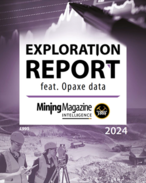This article is 18 years old. Images might not display.
Published in March 2006 Australian Longwall Magazine
Mapping subsurface geology through overburden, with the aim of delineating structures and igneous rock forms, is a major challenge for coal explorers and coal miners. Geophysical data such as aeromagnetics are commonly used to investigate the geology in coal basins but this data is usually limited to resolving only the most magnetic and largest of geological features.
TargetMap is a new geophysical data-processing technique helping coal explorers and miners obtain more geological information from aeromagnetic data.
Developed in Western Australia by Perth-based geophysical consultant and researcher Stephen Mudge of Vector Research, TargetMap is a two-dimensional pattern recognition algorithm specifically for enhancing magnetic survey data. The new tool is setting new standards in geophysical mapping and assisting geological mapping in coal basins.
Modern high-resolution aeromagnetic data usually contain a lot of detail about the overburden and the basement geology that is often not clearly resolved by conventional data enhancement and display techniques. Overburden, such as the regolith, near-surface basalt, maghemite-rich surface paleodrainage systems and surface cultural features, usually produces strong geophysical responses that obliterate detail and obscure the response of the underlying geology. This is an additional challenge for geologists using aeromagnetics for mapping and exploration targeting.
TargetMap is designed to resolve detail in survey data and to “see” the subsurface geology and its structures through the masking effects of overburden and cultural interference. It can resolve deeply buried bodies through the overburden response and through the interfering effects of magnetic basalt flows, and cultural features such as buildings and other infrastructure.
In addition, TargetMap can delineate linear and curvilinear features that are usually related to igneous dykes, and structures, bedding and boundaries of rock formations. Often strong linear and curvilinear responses are associated with overburden features, for example, paleodrainage and fractures in surface basalt flows are sometimes related to paleotopography and structural features in the underlying geology. TargetMap also removes the linear and curvilinear features from the survey data to reveal “spot” anomalies and high-frequency “textural noise”, which can usually be correlated with variations in the surface geology.
The new technique is being used by geologists to quickly interpret complex survey data to produce more accurate geological models and better exploration targets. It is also being used by a number of Government Geological Surveys for regional mapping in a variety of mineral provinces.
In Australia, the Queensland Geological Survey recently used TargetMap to enhance regional aeromagnetic data from the Bowen Basin coalfields as part of a major geological mapping program. TargetMap was able to resolve geological detail in the overburden; help clarify the subsurface geology; reveal the presence and extent of magnetic basalt and dolerite dykes, sills and flows in the Basin; and assist in mapping structures such as faults. The results were also a significant complement to gravity and radiometric data.
TargetMap has proved to be the fastest and cheapest way of revealing detail in aeromagnetic data to assist geological mapping of coal basins. A number of coal explorers are using aeromagnetic data enhanced with TargetMap to assist geological mapping in the Bowen Basin, and in the Sydney Basin in New South Wales.
Similarly, processed low-level high-resolution aeromagnetic data have also been used for detailed basement mapping as part of coal mine planning.
Australia leads the world in the availability of high-quality geophysical survey data to assist mineral and petroleum exploration. This is testified by the large volumes of airborne magnetic data available from government agencies, much of which is available free or for the cost of copying.
As a consequence, this has lead to a new era in exploration spending – more of the precious exploration funds traditionally spent on data acquisition are now being reallocated to reprocess survey data to reveal subtle and important geological detail in the vast volumes of data available. TargetMap is meeting this requirement for an increasing number of coal explorers.
TargetMap is a significant new development in the application of geophysics to geological mapping, and is playing an important role in the mapping of coal basins. It is also being used by a large number of hard rock mineral explorers to identify drill targets for a wide range of mineral commodities, including iron ore, heavy mineral sands, base metals, nickel and gold.
* Stephen Mudge is consulting geophysicist at Vector Research.























